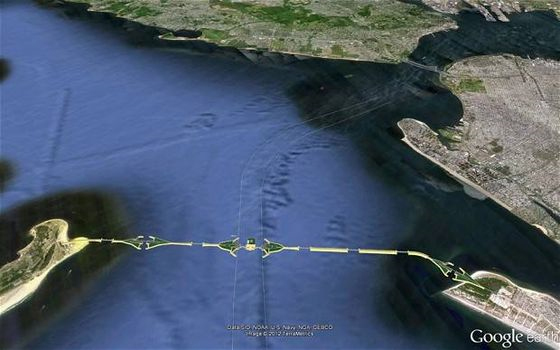February 28, 2013 - "Defending New York City Against Hurricanes With Barriers"
Duration: 27 minutes 8 seconds
SBU investigator Malcolm Bowman begins speaking at approximately 3 minutes 37 seconds into the broadcast
In the aftermath of Hurricane Sandy, there have been a number of proposals to waterproof the New York waterfront. One idea is to erect large—and expensive—storm surge barriers.
Panelists talk about the proposals:
Alex Marshall, author of "The $5.9 Billion Question" in the February issue of Metropolis magazine (pdf) and author of the new book The Surprising Design of Market Economies
Malcolm Bowman, distinguished professor of oceanography at Stony Brook University
Piet Dircke, and global director for water management for ARCADIS
"Superstorm Sandy created tremendous damage," said host Leonard Lopate, then asking Bowman, "Where would we need to place barriers around New York to prevent the type of destruction we witnessed during Sandy?"
"Back in 2009, I helped to organize a conference at Brooklyn PolyTech sponsored by the American Society of Civil Engineers," said Bowman. "Various major engineering firms [including Piet's ARCADIS group] were given assignments to look at different locations around the Harbor and see what they could come up with in terms of conceptual designs for storm surge barriers."
One firm was given the Upper East River. ARCADIS was given the Verrazano Narrows — (pictured at top left): Piet Dircke's conceptual design for a flood barrier in
the Verrazano Narrows, as part of an integrated flood protection plan
for the Hudson Bay.
Halcrow Inc. was given the Outer Harbor Gateway, which is further out by Sandy Hook, New Jersey and Far Rockaway — (pictured below) Halcrow's proposed design.

How many of these proposals might be considered depends on, what Bowman
said, "how much of the Metro NY region you feel you need to protect." When
it came to Hurricane Sandy, Bowman pointed out that most of the
casualties were in the southeastern coast area of Staten Island. The Verrazano Narrows is to the west of there, so, if a barrier is put up, Lopate asked if it would do much for the eastern side of Staten Island.
"No, it wouldn't, and this is no reflection on ARCADIS at all," said Bowman. "In term of the geography, you have to keep in mind that there are 2-3 million people in the outer boroughs of Brooklyn and Queens who live less than six feet or two meters above sea level. We have the three major airports, including Newark and Kennedy, built right on the water's edge. And so, an Outer Harbor gateway — and we could certainly use ARCADIS' designs — would protect all those regions I just mentioned."
"Well, Malcolm, if we built barriers, the water maybe won't flood New York Harbor, but it's going to have to go somewhere," said Lopate. "If you have a surge in water, the water isn't going to just go back where it came from, is it?"
"Anticipating the storm's arrival, you close the gates at low tide," said Bowman. "That's six feet down to start with. And then, as the storm approaches, the Harbor is shut off and the storm surge will build up on the outside of the barrier. So, it [ends up being] no more or a few inches more than it would've been if the gates weren't there. It's not so much this huge slug of water that's going to come crashing into the Harbor and is suddenly stopped dead in its tracks and then splashes elsewhere. It doesn't work like that."
In addition to talking more about the proposed storm surge barriers, the panel chat about some of the other ways the city could minimize the impact of severe storms — from recreating marsh lands to installing porous sidewalks that can absorb stormwater.
"The buzz word in New York is resilience following a catastrophe like Sandy" said Bowman. "The weak spots have been identified and strengthened so that hopefully next time around they will be protected. It's a kind of patch-up in a way, but it's necessary. But it's not sufficient in protecting against a huge, megastorm like Sandy. You need a family of solutions, but growing seaway in New York Harbor and growing oyster beds would've done nothing to stop the Sandy surge that flooded lower Manhattan."
About the show:
Host Leonard Lopate lets listeners in on in-depth conversations with writers, actors, ex-presidents, dancers, scientists, comedians, historians, grammarians, curators, filmmakers, and do-it-yourself experts.
WNYC 93.9 FM and AM 820 are New York's flagship public radio stations, broadcasting the finest programs from NPR and Public Radio International, as well as a wide range of award-winning local programming. WNYC is a division of New York Public Radio.